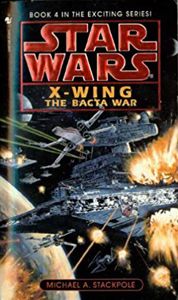In “X-Wing: The Bacta War” (1997), the final book of the Rogue Squadron quadrilogy (but not the last book about the squadron, as it’ll pop up again in “X-Wing” Book 8, “Isard’s Revenge”), the Rogues truly go rogue. At the end of “The Krytos Trap,” they collectively resigned from the New Republic military in order to take on Imperial nemesis Isard, who had been elected as the head of the bacta-producing planet Thyferra.
As with Michael Stackpole’s first three entries, this one is a brisk page-turner that doesn’t waste a word. But in some cases, I felt more words would’ve been welcome: For example, I had thought that the politics of choosing military targets would be a focal point of “The Bacta War.” The New Republic says it can’t go after Isard, because — evil or not — she was elected by a vote of the Thyferran people. That’s a fascinating question: Should the way in which an evil person gains power make a difference to a military whose aim is a free galactic citizenry? And why is the fact that Isard is imprisoning Rebellion heroes, such as Jan Dodonna, not considered a good enough reason to go after her?
However, the Rogues’ politically necessitated break from the New Republic is merely a jumping off point for “The Bacta War,” not to mention Book 5, Aaron Allston’s “Wraith Squadron,” which chronicles what the New Republic is up to during this time period — namely, going after Warlord Zsinj.
While Stackpole courteously hands off Zsinj to Allston, he arguably did himself a disservice by killing off two compelling villains, Isard’s underlings Kirtan Loor and Evir Derricote, in “The Krytos Trap.” Isard — quite interesting when she was engaged in political maneuvering on Coruscant — turns into a cackling, cliched villain specifically obsessed with Wedge Antilles in “The Bacta War.” There are a few new underlings, but none really pops off the page. Most disappointing is Erisi, the traitorous former Rogue who now heads the Elite Squadron of TIE Interceptors and is obsessed with Corran Horn.
(On a side note, the “Star Wars” galaxy feels like a vast playground when there aren’t so many deeply personal vendettas between good guys and bad guys. The villains’ obsession with specific heroes shrinks the galaxy. Maybe that’s understandable in the “X-Wing” books, which zero in on a specific group on a specific mission. Still, I find it somewhat bothersome when a random Imperial notes that “the freighters have the survival rate of tauntauns on Tatooine.” Luke or Han could make such a reference, but I don’t like the idea that everyone is familiar with every planet and its respective fauna and climate.)
But Stackpole makes up for Isard’s and Erisi’s sudden shallowness in a big way with his portrayal of wheeler-and-dealer Talon Karrde, who was introduced by Timothy Zahn in 1991’s “Heir to the Empire.” In what might be the finest example of one author using another author’s creation, Stackpole shows Karrde — who knows all the ins and outs of galactic law — ingeniously working out a deal between the New Republic, Booster Terrik and himself where everyone benefits.

Another oddity in “The Bacta War” is that Stackpole sets aside the Lusankya prisoners as a front-and-center plot point. As a reader, I knew they were in the picture, particularly when the Rogues and their allies attack the Lusankya, but Stackpole largely refrains from mentioning them. I suppose it goes back to Stackpole’s economy of words. And certainly, one can assume this plot thread will be picked up in a future book.
Stackpole might be the most prolific “Star Wars” writer in terms of the speed with which he cranked out great yarns. He penned the Rogue Squadron quadrilogy in about a year’s time in 1996 and ’97 while also producing monthly “X-Wing Rogue Squadron” comic books (to be the subject of a future flashback installment). Certainly, he’s a great writer. But “The Bacta War,” more so than any of his previous works, raises has a lot of “What abouts?” What about Erisi’s motives? What about Isard’s political and military thinking? What about concern for the Lusankya prisoners?
Then again, there are only so many pages, and only so many hours for Stackpole to crank out these pulp masterpieces. So perhaps every missed opportunity made room for an embraced opportunity.

